21 Traditional Spanish Foods To Try in 2025
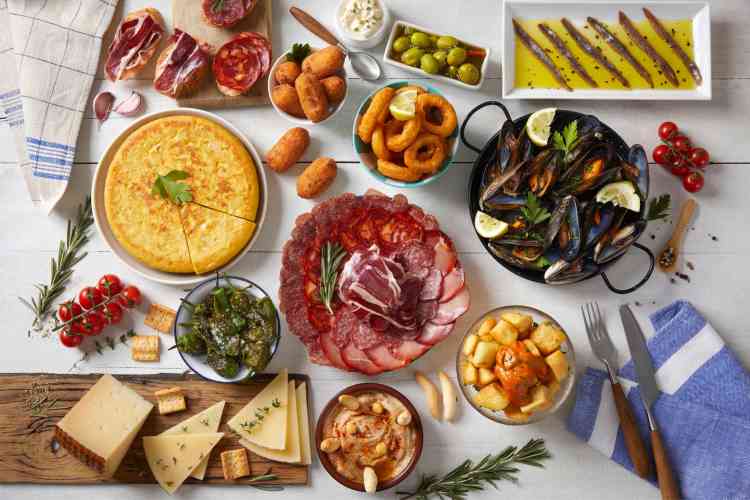
Spanish food is synonymous with the flavors of sunshine. The culinary scene here also has a rich history, and food is a huge part of Spanish culture. According to Le Cordon Bleu, food and drink are a crucial part of the culture and the way of life of Spaniards, allowing them to build bonds over food.
It’s additionally fair to say that traditional Spanish food is as much a draw for vacationers as the country’s climate, history and landmarks.
If you’re along the coast and enjoying the Mediterranean weather, you’ll find dishes that draw from the country’s natural coastal larder. Yet, when spending your time in-land, on the Iberian peninsula, for example, there’s a whole different menu to be sampled, including some specialty items that simply cannot be found anywhere else.
All of this makes a tasting tour of iconic Spanish food an exciting prospect, if not one that requires some inside knowledge in order to get the most out of your mission. That’s what we’re here to help with.
In this guide, we’ll take a deep dive into the best Spanish foods to try. In doing so, we’ll narrow down the long list of the country’s culinary specialties, helping you to build an epicurean itinerary that, regardless of where you’re planning to visit, allows you to skip straight to the very best Spanish dishes.
Jump to Section
How We Choose These Popular Spanish Foods
It may sound obvious, but our focus when curating this guide is Spanish cuisine in Spain. We say that because there are plenty of dishes and, indeed, entire cultures around the world that take influence from this country’s culinary heritage.
And while there are many likenesses, especially in countries across Latin America, there’s no better place to get a true taste of traditional Spanish food than the European motherland itself. Fortunately for us, we have access to countless chefs around the world, many of whom draw inspiration directly from the Spanish foodie landscape.
Add to that the firsthand knowledge of our editorial team and a robust research process by which we scour the internet for insights from like-minded foodies who have walked Spain’s most hallowed culinary ground, and what we have is a fascinating and mouth-watering guide to Spanish dishes that are worthy of any foodie’s bucket list.
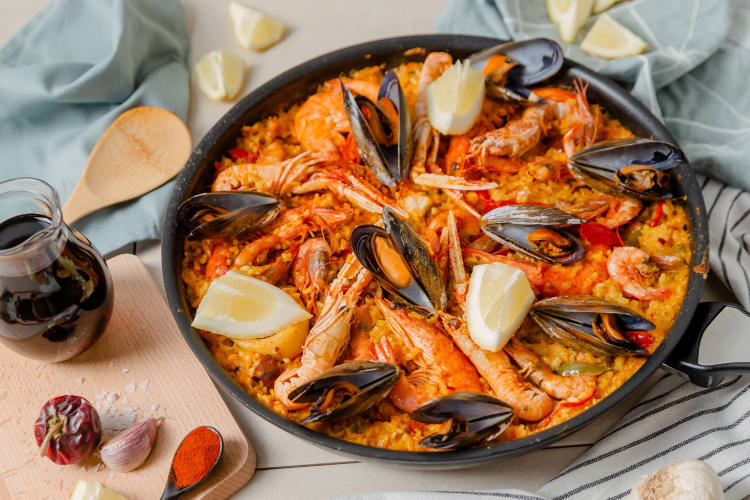
21 Iconic Spanish Foods To Try
1. Paella Valenciana
We’ll kick off this guide to Spanish food with one of the nation's most iconic dishes: paella. With roots in Valencian food culture, it’s a dish that has stolen the hearts of foodies around the world.
It’s especially popular in the summer, when the vibrant, saffron-infused flavors and single-pan style of cooking make it a fantastic means of feeding the masses with minimal fuss. The word “paella” itself refers to the flat, round pan in which this popular Spanish food is cooked.
This dish comes in two traditional varieties. The one named above — paella Valenciana — features rabbit and chicken. But it’s also commonly made with seafood. Both versions of this Spanish food are absolutely delicious, especially when cooked to achieve the flavorful crust on the bottom layer of rice, known in Spanish as the “socarrat.”
You may even find other variations to try, such as vegetarian or vegan paella; however, these don’t hold the title of being the traditional Spanish recipe.
- Pairs With: An earthy, fruity red like tempranillo stands up well to the robust flavors of this Spanish food.
- Suitable For: Meat eaters (but can be made pescatarian, vegetarian or even vegan).
- Cooking Notes: The trick to authentic flavor is in the socarrat — a crust that forms on the bottom layer of rice towards the end of the cooking process.
- Where To Buy: Restaurants across the country serve this Spanish food, but those in Valencia are likely to provide the most authentic experience.
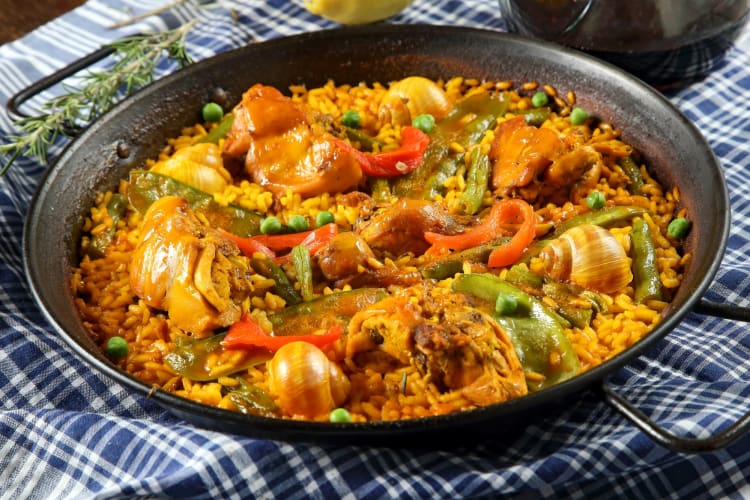
2. Fideuà
This Spanish food is similar to paella in terms of its flavors and how it’s cooked (in a paella pan). The main difference? It uses short, noodle-like pasta (called “fideo”) instead of rice. It’s typically made with seafood, including shrimp, squid and mussels.
Fideuà’s similarity to paella makes sense given its widely-held origin story. It’s believed that it was created by a cook on a Valencian fishing boat who, running low on rice, decided to make his favorite paella with noodles.
The dish quickly caught on and today remains one of the most loved dishes in Spain. If you’re a few hours up the coast from Valencia, don’t worry — fideuà is also a firm fixture on the Barcelona food scene.
- Pairs With: A crisp white like verdejo offers acidity and citrus notes that work well with the seafood.
- Suitable For: Pescatarians.
- Cooking Notes: Follow a similar recipe to seafood paella but substitute rice for fideo (noodles).
- Where To Buy: Coastal spots like Valencia and cities like Barcelona are great places to try this dish.
3. Gazpacho
This cold soup is one of the best Spanish foods to try on a sweltering summer’s day. While its origins are uncertain, some believe that it was first created by farmers in a bid to use up dry bread.
Whether or not that’s true, it’s generally agreed that this refreshing Granada food hails from Andalusia in the country’s south, with recipes for the dish traceable there as far back as the 16th century.
It’s made with a tomato base plus simple ingredients like peppers, garlic and olive oil, all of which remind you of why you made the effort to visit the Mediterranean.
- Pairs With: A dry Spanish white from Rueda is perfect and won’t overpower the dish’s delicate flavors.
- Suitable For: Vegetarians and vegans.
- Cooking Notes: Once the soup is made, chill for at least two hours.
- Where To Buy: Many restaurants offer this Spanish food on their menus, especially in the summer and in Andalusia.
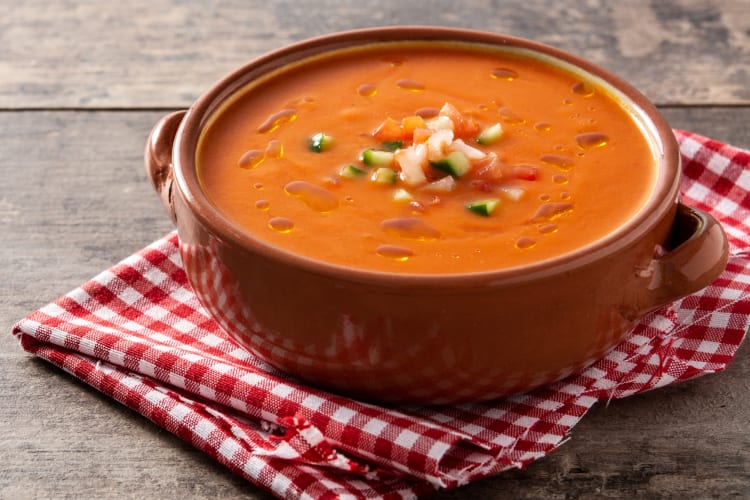
4. Patatas Bravas
This is a Spanish food you’re likely to find on menus of tapas bars across the country, especially those on the Seville food scene, and even across the world. Translated as “brave” or “fierce” potatoes, the name is said to relate to the somewhat spicy sauce that accompanies the namesake vegetable.
The potatoes are typically cubed and fried, and while the sauce can vary, it almost always features paprika (sweet, smoked or both). You may also see this dish topped with aioli or a drizzle of spicy sauce.
- Pairs With: A crisp, dry white like albariño is essential in order to stand up to this Spanish food’s heat and richness.
- Suitable For: Vegetarians and vegans (depending on the sauce).
- Cooking Notes: Cubing the potatoes and frying them until crispy is essential to recreating this dish.
- Where To Buy: Tapas bars across the country (and globally) typically serve this Spanish food.
5. Pimientos de Padrón
A Spanish food that you’ll find in tapas bars across the country, this one hails from the country’s rainy northwest, specifically from the town of Padrón in Galicia. It’s believed that the peppers were first grown in the Herbón area (near Padrón) by Franciscan monks, who introduced pepper seeds brought over from the Americas.
The dish features green Padrón peppers fried simply in olive oil before being served with a dash of salt. While the dish is generally mild and even sweet (which is complemented deliciously by the salt), every now and then, you’ll come across a spicy pepper. In other words, it can pay to take your first bite of this Spanish food with care.
- Pairs With: Light-bodied and refreshing Spanish whites like Verdejo, which can help cleanse your palate while standing up to the potent pepper flavor.
- Suitable For: Vegetarians and vegans.
- Cooking Notes: The key to this simple dish is quality ingredients, including the peppers, olive oil and salt.
- Where To Buy: Tapas bars across the country will serve this Spanish food, especially those in the northwest. You can likely find these peppers on the menu at tapas bars around the world as well.
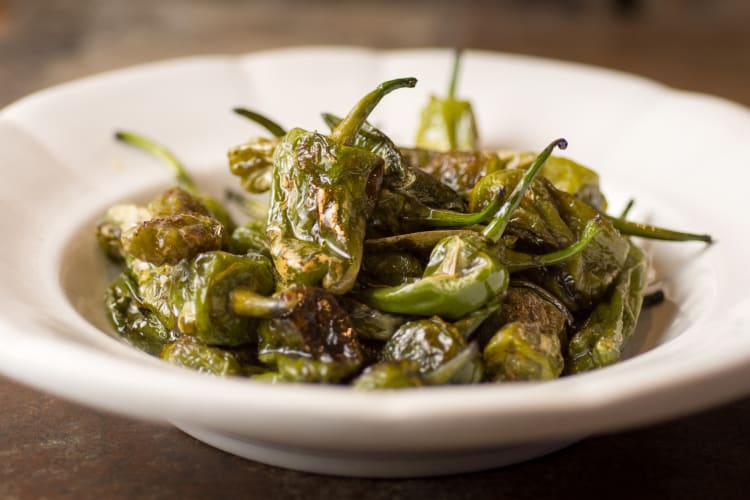
6. Jamón
As one of the most celebrated Spanish foods on this list, jamón is surprisingly simple. Known in other parts of the world as cured ham, in Spain, jamón was traditionally salted and hung to dry in order to preserve it through the winter months.
Today, it can be enjoyed at restaurants across the country, where it’s usually served in thin slices that melt tenderly in your mouth. This Spanish food is most commonly sold as jamón serrano (meaning ham from the sierra, or mountain range), which comes from white pigs.
If you’re lucky, you might also come across jamón Ibérico. While a more expensive food, the deep marbling of Ibérico pork (more on this later) is absolutely worth the price tag.
- Pairs With: The acidity and freshness of dry sherries like Manzanilla cut through the fatty richness of this Spanish food perfectly.
- Suitable For: Meat eaters.
- Cooking Notes: Slice the meat thinly so that it melts in your mouth.
- Where To Buy: You’ll find varieties of jamón available in food shops and restaurants around the country. Outside of Spain, high-end grocery stores and specialty meat shops will sell Spanish-style jamón.
7. Tortilla
Commonly mistaken for the floury flatbread, in the world of Spanish food, a tortilla is more akin to an omelette than a wrap. It traditionally contains potatoes and eggs, making it one of the simplest Spanish foods on this list, but it’s also often cooked with other ingredients like chorizo, onions and peppers.
Interestingly, potatoes are a relatively recent addition to the Spanish diet, having only been introduced to Spain by conquerors returning from the Americas. Today, however, it’s a firm favorite, serving as another example of Spain’s inimitable approach to simple but utterly delicious cuisine.
- Pairs With: A bright and acidic white wine like albariño will cut through the richness of this Spanish food.
- Suitable For: Vegetarians.
- Cooking Notes: Slicing the potatoes and frying them until almost cooked is key. Note also that flipping the tortilla mid-cook requires care and attention.
- Where To Buy: Tapas bars across the country are likely to serve this Spanish food.
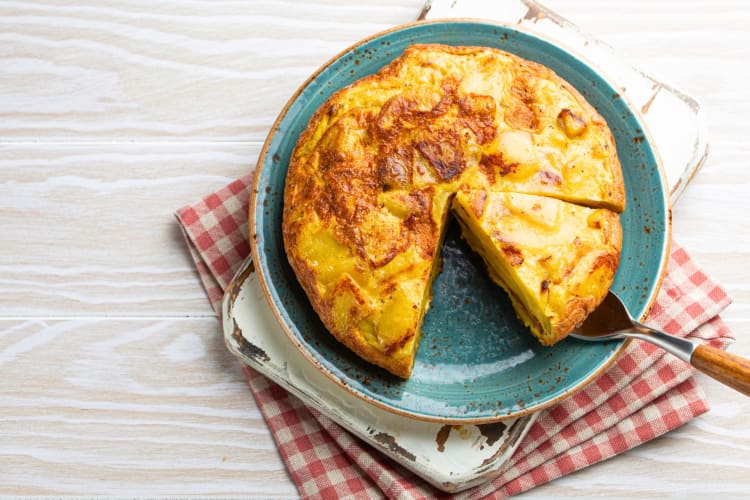
8. Migas
Migas hold legendary status on the Spanish food scene not only for their humble origins (having first been made by laborers who needed to get creative with the ingredients available to them), but also for the delicious number of ways in which they can be served.
At its core, this Spanish food typically features dried bread, which is torn, fried and scrambled with eggs. Sometimes chorizo and/or bacon are also added. It sounds simple, but don’t let that fool you. This dish is a must-try for anybody exploring Spain’s culinary heritage.
- Pairs With: A crisp, citric and acidic white wine like verdejo will cut nicely through the inherent richness of this Spanish food.
- Suitable For: Vegetarians and meat eaters, depending on what ingredients are used.
- Cooking Notes: This is a great dish with which to get creative. Think eggs, chorizo and other Spanish foods like jamón.
- Where To Buy: Restaurants around the nation serve this Spanish food.
9. Churros
Sweet, simple and extremely difficult to resist, this Spanish food is sure to curb the cravings of even the sweetest tooth. In their simplest form, churros are made from sausage-shaped strips of dough, which are fried to golden perfection and dusted with sugar. They’re often served with hot chocolate for dipping.
Whether you’re enjoying one of Spain’s many sun-soaked festivals or perusing the street food stalls of whichever town you’ve decided to visit, there’s a good chance you’ll stumble across a churros stand. When you do, we urge you: buy some!
- Pairs With: Chocolate!
- Suitable For: Vegetarians and vegans (provided eggs aren’t used in the batter).
- Cooking Notes: Churros are also delicious without a sugar coating, especially when you have some melted chocolate to hand.
- Where To Buy: You’ll find this Spanish food on stalls in towns and cities across the country.
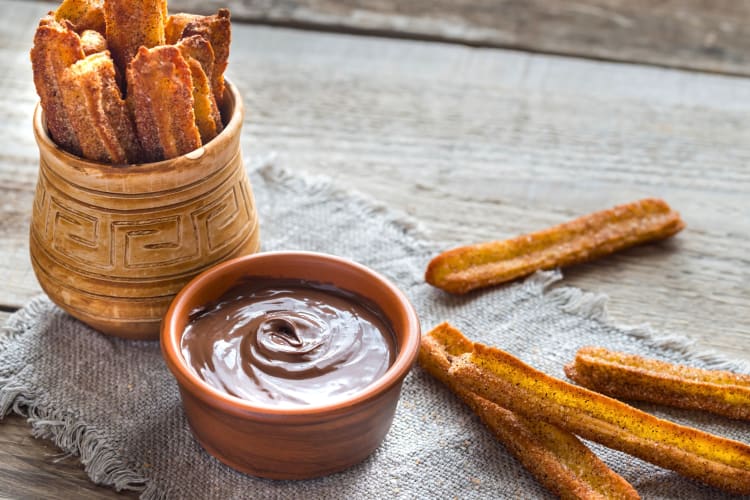
10. Albondigas
When we describe this dish as meatballs in a tomato sauce, you’ll be forgiven for wondering whether it’s actually an Italian food. But it’s not. It’s a classic Spanish food served in tapas bars around the country.
The meatballs are typically made with minced beef, pork or veal (sometimes a combination of all three), which are then mixed with onion, garlic, breadcrumbs and egg. The meatballs are then served in a brothy tomato sauce.
Interestingly, it’s thought that this was a Berber or Arab dish, introduced to the Spanish food menu around the 8th century, when parts of the country were under Muslim rule. Of course, the ultimate credit for the invention of meatballs is hard to pin on any one particular nation.
What helps this version stand out as a Spanish food is the local ingredients and Spanish culinary traditions that have evolved over more than a thousand years.
- Pairs With: A Spanish Rioja (red or white) will help to balance the savory flavors of the meatballs and the tomato-based sauce.
- Suitable For: Meat eaters.
- Cooking Notes: Egg helps to bind the meatballs, but you only need one small egg for around a pound of meat. Too much can make the meatballs tough.
- Where To Buy: This Spanish food is widely available at tapas bars, especially in the Andalusia region, where the dish is first thought to have been created.
11. Croquetas
How does a tube of béchamel sauce encased in fried breadcrumbs sound? If you’re anything like us, that description will have you immediately wondering how on Earth you can get your hands on some.
Given how fiddly these are to make, we’d recommend visiting a Spanish tapas bar. Do so, and you’ll likely find this Spanish food made with various additions to the base recipe, including jamón and even salted cod.
They often come with a dipping sauce, too, although they don’t really need it. A bowlful of croquetas and a dewy glass of beer has satisfied many a Spanish foodie since its 19th-century introduction to the country.
- Pairs With: A cold beer.
- Suitable For: Vegetarians (assuming meat or fish is not added).
- Cooking Notes: Chill the béchamel sauce to make it easier to shape and coat in breadcrumbs.
- Where To Buy: Tapas bars around the country (and further afield) serve this comforting Spanish food.
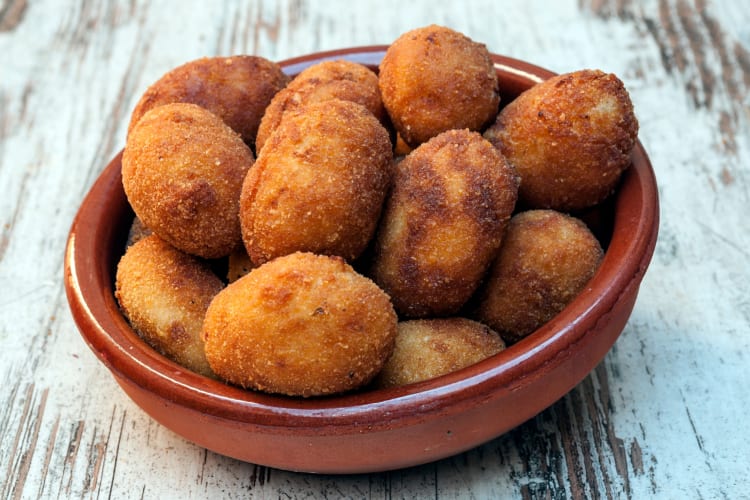
12. Bacalao
If you like seafood, you’re sure to love this Spanish food. Otherwise known as salted cod, what’s interesting is that cod isn’t typically found in Spanish waters. Instead, it was historically brought back by fishermen from as far away as Norway and even Newfoundland — a long journey would see the fish spoil if it wasn’t heavily salted.
Today, the salt is probably added out of a desire for a traditional taste rather than as a necessary means of preservation. As for where (and how) to enjoy it, it’s a staple of the Bilbao food scene, where it’s typically served with a pil-pil sauce made of garlic, olive oil and juice from the fish.
- Pairs With: Albariño wine’s natural hint of salinity complements the fish perfectly.
- Suitable For: Pescatarians.
- Cooking Notes: There are many recipes that call for bacalao. It’s especially well suited to soups and stews.
- Where To Buy: Restaurants in Bilbao and the Basque Country are known for serving this delicious Spanish food.
13. Fabada
You’re probably starting to spot a trend in this guide to Spanish food, and that’s simplicity. It’s somewhat indicative of the country’s approach to cuisine, and fabada is a great example.
Essentially a one-pot stew made with white beans (usually fabes de la Granja) and pork — including chorizo, pork belly and bacon — this dish is the epitome of comfort food. It originates in northwestern Spain, specifically the Asturias, where the cool, rainy season often calls for bowls that warm the soul.
- Pairs With: A dry, medium-bodied red wine like Rioja will stand up to the savory flavors of this hearty dish. So, too, will an Asturian cider.
- Suitable For: Meat eaters.
- Cooking Notes: This Spanish food can be made with many varieties of pork, including morcilla — a traditional Spanish blood sausage.
- Where To Buy: Restaurants in Asturias are likely to serve this Spanish food.
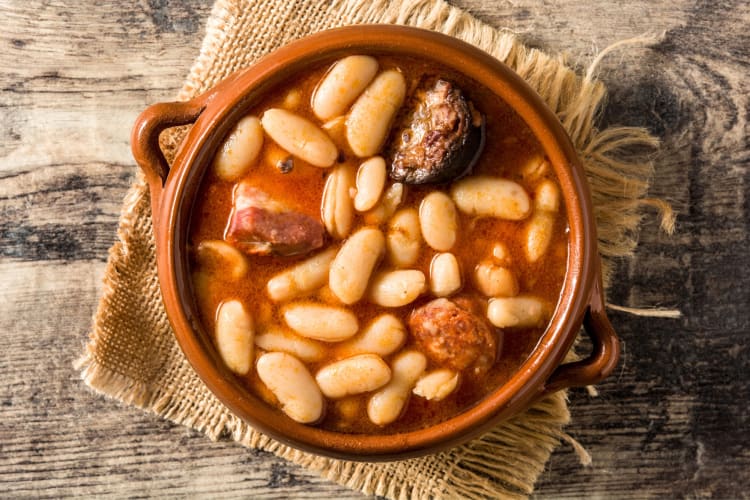
14. Leche Frita
Who knew that you could fry milk? This popular dessert is a staple Spanish food for those with a sweet tooth, and it’s pretty straightforward to make.
Simply whip together milk, egg yolks and flour, chill the mixture until it solidifies, then fry it in a breadcrumb coating. Hot or cold, it’s delicious, especially with a dusting of sugar before plating.
While its precise origins are hotly debated, it’s often associated with nuns in convents in the northern regions of Spain, who made these fritas as a way to use up leftover milk. It’s traditionally an Easter food, but hey — it’s often enjoyed year-round by Spanish foodies, so there’s nothing stopping you from doing the same.
- Pairs With: If you’re enjoying these for dessert, try pairing them with a Spanish sweet wine like Malaga.
- Suitable For: Vegetarians.
- Cooking Notes: Let the milk, egg and flour mixture solidify in the fridge before shaping and frying.
- Where To Buy: Pastry shops (pastelerías), especially in Castile and León. You might also find them in the Basque Country and the Asturias served with honey or fruit.
15. Gambas al Ajillo
Featuring shrimp sautéed in garlic-infused olive oil, with dashes of smoky paprika and some sherry-based sweetness, this Spanish food makes the menus of restaurants across the country.
It’s another example of how Spanish cuisine is often greater than the sum of its parts. In fact, it’s probably the best example, which is why (provided you eat seafood) you absolutely have to try this Spanish food during your next trip.
- Pairs With: Look for wines with citrus notes to enhance the shrimp’s natural sweetness. Sauvignon blanc, while not Spanish, is always a good choice.
- Suitable For: Pescatarians.
- Cooking Notes: This Spanish food is simple to recreate — just fry some garlic and chiles in olive oil, then add the shrimp and some Spanish paprika and cook for a few minutes until the shrimp are tender. Finish the dish with a splash of dry sherry (or white wine) and some lemon juice.
- Where To Buy: Tapas bars around Spain and across the globe are likely to serve this dish.
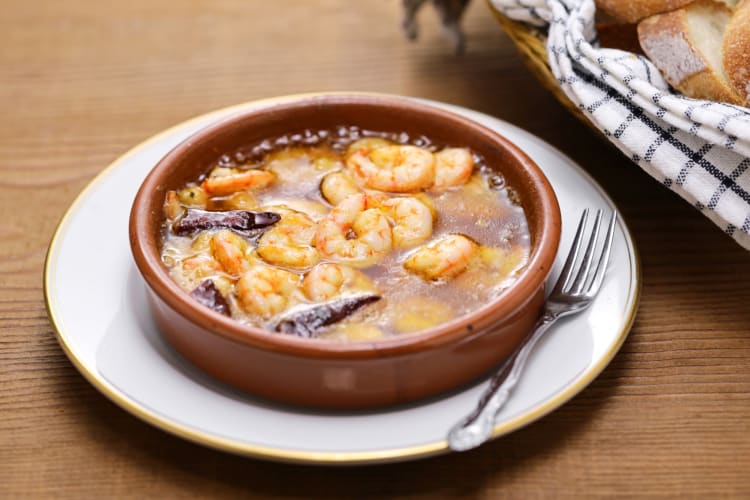
16. Tostas de Tomate y Jamón
Anyone with an eye for the Spanish language may well already know what to expect from this Spanish food. It features toasted bread, rubbed with garlic and tomato and topped with melt-in-your-mouth slices of ham.
The result? A dish that, while you’ll order it for the table, you’ll be less than inclined to share.
It’s similar to a dish called “tostas con tomate” or “pan con tomate,” which is thought to have been created as a way to enliven old bread with the ripe pulp of tomatoes. This is also worth a try if you spot it on a Spanish food menu!
- Pairs With: A crisp, acidic Spanish white wine like albariño pairs with a variety of Spanish foods, especially jamón.
- Suitable For: Meat eaters.
- Cooking Notes: Use quality ripe tomatoes and fresh garlic to top the bread.
- Where To Buy: This can be found at tapas bars and restaurants around the country. It’s also very easy to make at home.
17. Pollo al Ajillo
This is yet another example of Spanish food’s characteristic simplicity, one whose name translates as “chicken with garlic.” As for its origins, they’re not well documented, but it’s thought to have roots in Southern Spain’s Andalusia region.
The flavor for the dish is formed by frying unpeeled cloves of garlic in olive oil. The garlic is then removed and replaced with chicken, before being returned along with herbs like rosemary and thyme. A splash of sherry or white wine completes the delicious ensemble.
- Pairs With: A dry Rioja rosé’s acidity will cut through the rich garlic flavor nicely.
- Suitable For: Meat eaters.
- Cooking Notes: As with most Spanish foods with minimal ingredients, quality produce is key to great results.
- Where To Buy: Restaurants around the country are likely to serve this Spanish food.
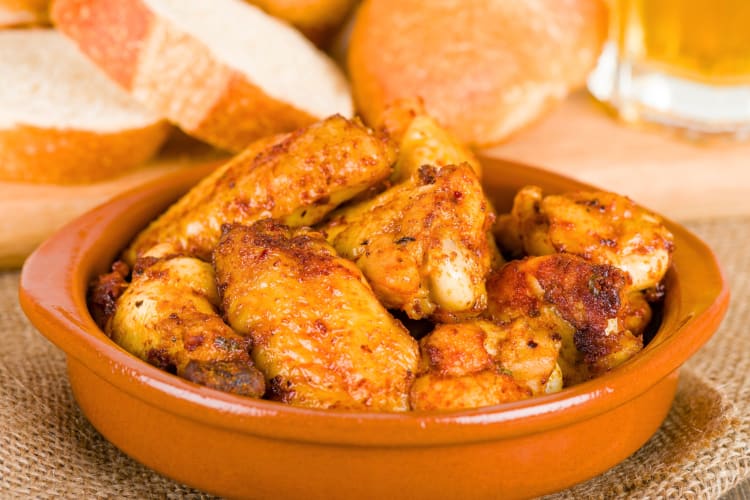
18. Cochinillo Asado
This dish features milk-fed and aged suckling pig, cooked to tender perfection with skin that’s impossibly golden and crispy. It’s a must-try, especially if you’re exploring what has to be one of Spain’s best foodie cities, Segovia.
In terms of its origins, records of this dish date back to the 17th century. It has ties to the farm-to-table eating culture of Spanish food, especially in the Castilian region.
As for how it’s eaten, if you’re lucky enough to try it in Segovia (where the dish was perfected), you might just enjoy a traditional wood-fired pig that’s carved right at your table.
- Pairs With: A fruit-forward Rioja is the perfect pairing for this fatty Spanish food.
- Suitable For: Meat eaters.
- Cooking Notes: If you’d like to recreate this Spanish food at home and have the equipment, try wood-smoking the pig until it’s fork-tender. It takes time, but it’s absolutely worth it.
- Where To Buy: Sample this dish in restaurants across the Castilian region.
19. Pisto
While it sounds similar to one of Italy’s greatest pasta accompaniments, this classic tapa dish is actually a signature item from the Spanish food menu. Some have described it as a Spanish take on ratatouille, since it features a medley of slow-cooked vegetables that melt in your mouth.
The vegetables are slow-fried in olive oil and, once ready, sit comfortably on the side of any number of other tapas dishes. You can also create a main meal out of it by adding eggs or chorizo.
- Pairs With: A crisp white wine like verdejo works beautifully with the vegetables’ natural sweetness.
- Suitable For: Vegetarians and vegans (depending on additional ingredients used).
- Cooking Notes: Patience is the key to this Spanish food. Slow fry the vegetables on a low heat to achieve perfect tenderness.
- Where To Buy: Look for this Spanish food on restaurant menus across the country, especially in the Castilla-La Mancha region, where it’s thought to have originated.
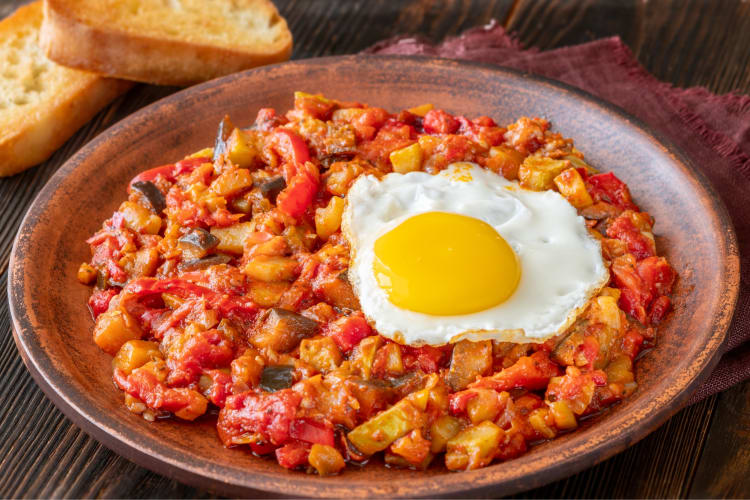
20. Ibérico Pork
As you might have guessed by the name, this Spanish food hails from the country’s Iberian Peninsula. The pork itself comes from the Black Iberian Pig, whose diet of acorns and other items from their forest habitat gives the meat a distinctive and highly sought-after flavor.
They are also bred to contain a higher fat content than other breeds, which lends the meat an incredible degree of marbling. As any foodie will tell you, that means flavor — and lots of it!
If it’s your first time trying Ibérico pork, we recommend cooking it simply and without adornment in order to fully appreciate its flavor. However, it’s also worth noting that it's one of the most versatile types of pork for cooking. Whether you roast it, grill it or cure it to create wafer-thin slices of jamón, the result is all but guaranteed to be delicious.
- Pairs With: An aged red Rioja or pinot noir wine pairs well with this Spanish food. Many also go for a sherry to counteract the richness of the meat.
- Suitable For: Meat eaters.
- Cooking Notes: It’s best served medium rare, ensuring the meat rests after cooking. If slicing the pork for jamón, get it as thin as possible.
- Where To Buy: This type of pork will be served in various ways at restaurants across the country, especially on the Iberian Peninsula. You can also find it for sale in butcher shops in Spain. High-end grocery stores and delis may have Ibérico pork outside of Spain.
21. Turrón
While it looks a little like an artisan cheese, this honey, egg and almond-based treat is one of the most loved sweet treats on the Spanish food scene. It’s mostly made in a small town called Jijona in Alicante.
As for its origins, it’s held that the Moors — who ruled much of Spain between the 8th and 15th centuries — introduced the concept of blending almonds with honey to make sweet, energy-rich snacks.
You’ll typically find two different versions of this decadently simple treat. One is soft and smooth — named Jijona, after the town in which it’s made. The other is called Alicante turrón and features a harder texture with crunchy pieces of local almonds. If you’re unsure which version of this Spanish food to try, don’t worry. You’re unlikely to be disappointed by either.
- Pairs With: Spanish sweet wines, like oloroso sherry, help enhance the nutty, honeyed tones of this sweet Spanish food.
- Suitable For: Vegetarians.
- Cooking Notes: You’ll need to whip a hot syrup (made from honey and sugar) into egg whites, similarly to how you make meringues.
- Where To Buy: Shops around Alicante are the best place to find authentic versions of this Spanish food.

Learn To Cook Spanish Food
If this guide to the Spanish food landscape has inspired you to level things up in your own kitchen, you’re not alone. Perhaps you’ve been sampling the Michelin star restaurants in Barcelona and want to learn to bring a dash of that culinary creativity to your home dinner table. If so, cooking classes in Barcelona are the perfect chance to learn to do so.
Or perhaps Madrid’s food scene has stolen your heart, and you can’t face returning home to your old and tired weekly meal routine. If that sounds familiar, cooking classes in Madrid allow you to take more than just memories home with you.
Even if you’re not planning a trip to Spain, don’t worry. You’re sure to find cooking classes near you that can help broaden your culinary horizons. There are even online cooking classes available, perfect for connecting digitally with friends and family around the world and sharing the experience of learning something new.

All classes benefit from the guidance of a renowned chef with years of experience at the height of their industry. With their help, you’ll quickly get to grips with Spanish food traditions, learning everything you need to wow even your most discerning friends and family with the sun-soaked flavors of Spain.
This guide should have provided you with a hit list of Spanish foods to try the next time you visit. From classic paella and Valencian fideuà to the world-renowned, mountain-raised pork from the Iberian Peninsula, there’s plenty to sink your teeth into.
While it’s unlikely that you’ll have time to sample everything in this guide in a single trip, perhaps our favorite thing about Spanish food is just how simple it can be to cook. That means that even if you can’t make it in person, you can easily recreate a taste of its most mouthwatering dishes in your own kitchen.
For even more ways to explore your favorite foods, check out other experiences happening on Cozymeal.



FOOD FOR THOUGHT?
Join the conversation.